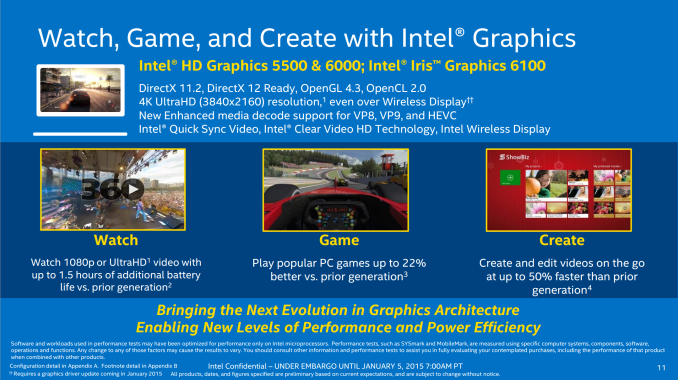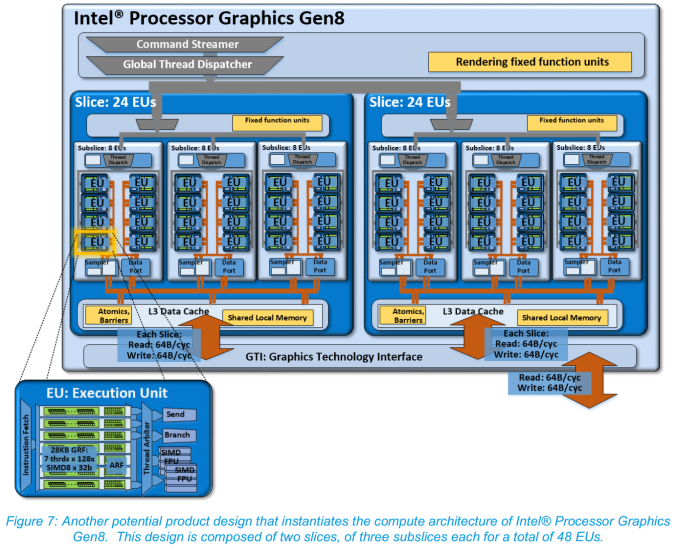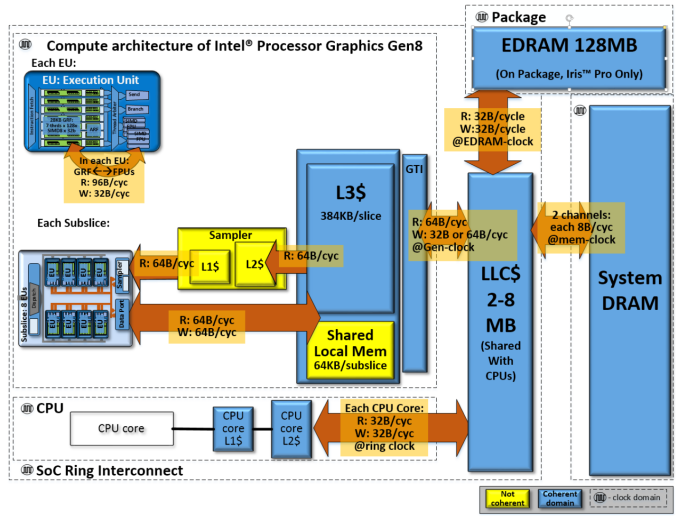Intel Releases Broadwell-U: New SKUs, up to 48 EUs and Iris 6100
by Ian Cutress on January 5, 2015 10:00 AM ESTBroadwell GPU Improvements
The new integrated graphics for Broadwell from Intel in the form of HD 5500, HD 6000 and Iris 6100 open up some very important functionality. DirectX 11.2, OpenGL 4.3 and OpenCL 2.0 are big scoring points, especially OpenCL 2.0 when it comes to graphics compute. This includes features such as shared memory coherency between CPU and GPU to allow transfer of pointer-rich memory structures and ultimately the beginnings of heterogeneous CPU + GPU compute.
‘DirectX 12 Ready’ is somewhat of an interesting case, and it depends on Microsoft’s final specifications. At this point in time Intel state that they conform to as much of DirectX 12 feature set that they can get their hands on with their relationship with Microsoft, and barring any major addition or change, should be compatible. UHD-4K is also now supported through the HDMI 1.4b interface, albeit limited to 24 Hz.
Support for HEVC is also present in terms of a combined (hybrid) hardware and software solution, just as it was on Core-M. Intel stated that as parts of the H.264 algorithm are near if not identical to those of the H.265, with a small tweak to the hardware it can be used for both. This is still not an all-encompassing hardware acceleration, but it does aim at some parts of the codec. I would speculate that if a full section of the silicon could be made for complete hardware acceleration, it might eat into certain power budgets.
GPU Slices
Although mentioned in our Broadwell architecture overview, for Broadwell-U we should cover the basics of the GPU layout. Below is an image of a HD 6000 implementation featuring two slices of 24 EUs each, with each slice having three sub-slices of 8 EUs. Each EU can handle 7 threads at once when in a 128xSIMD8 32-bit configuration. When in the right data structure, this offers a good amount of power, especially to coalesced 16-bit computation.
For Broadwell, Intel has reduced the number of EUs in a sub-slice from 10 down to 8. This is a big change, as it eases up the Thread Dispatch, Data Port and L1/L2 samplers in each EU as they have to deal with less data overall. By this logic, with two equivalent designs, one with 8 EUs per sub-slice should be able to get through more data due to less data bandwidth pressure and less competition for each sub-slice’s shared local memory.
Each slice has an L3 Data Cache, which for Gen8 is improved from 384 KB to 576 KB per slice. This ends up being split anyway as 64 KB per sub-slice as shared local memory and 384 KB for inter-slice L3 communication. More slices mean more caching overall, and as an aid to the last level cache outside the GPU, the Graphics Technology Interface has doubled the write bandwidth.
The principle behind caches is to provide a small amount of memory that can be accessed faster at the expense of size. The algorithms in place to predict which data is needed next (or preprogrammed data fetching) helps increase the overall speed of any CPU function, but increasing the size of a cache decreases the need for later caches by reducing the data misses that require trips further out. GPUs are historically bandwidth starved, both for gaming and for compute, so by virtue of having four named caches for the GPU to use and increasing at least the third, this should contribute to the large performance numbers Intel is producing in comparison to the previous generation.
In terms of throughput, Intel gives the following numbers for GT2 / 24 EU configurations:
32b FP: 384 FLOP/cycle = 24 EUs * (2 * SIMD-4 FPU) * (MUL + ADD)
64b DP: 96 FLOP/cycle = 24 EU * SIMD-4 FPU * (MUL + ADD) * 0.5 throughput
32b INT: 192 IOP/cycle = 24 EU * (2 * SIMD-4 FPU) * ADD
The Gen8 EUs will support 16-bit floats (half-floats) natively, as well as 16-bit integers.
We can construct a table calculating out to full performance:
| Intel Gen8 Graphics Throughput | |||
| Processor | 32b FP GFLOPs |
64b DP GFLOPS |
32b INT GFLOPs |
| i7-5557U (48 EUs at 1100 MHz) | 844.8 | 211.2 | 422.4 |
| i5-5257U (48 EUs at 1050 MHz) | 806.4 | 201.6 | 403.2 |
| i3-5157U (48 EUs at 1000 MHz) | 768 | 192 | 384 |
| i7-5250U (48 EUs at 950 MHz) | 729.6 | 182.4 | 364.8 |
| i7-5600U (24 EUs at 950 MHz) | 364.8 | 91.2 | 182.4 |
| i5-5300U (24 EUs a 900 MHz) | 345.6 | 86.4 | 172.8 |
| i3-5010U (23 EUs at 900 MHz) | 331.2 | 82.8 | 165.6 |
| i3-5005U (23 EUs at 850 MHz) | 312.8 | 78.2 | 156.4 |
| Pentium 3805U (12 EUs at 800 MHz) | 153.6 | 38.4 | 76.8 |
Having doubled the EUs not only doubles the performance but the extra bit of frequency also helps.
As we mentioned back in August, the sub-slice also gets some minor improvements to increase pixel and Z-fill rates, and the front end’s geometry units are also beefed up. Further reading can be found on Intel’s PDF on the Gen 8 Graphics Overview from IDF.













85 Comments
View All Comments
CharonPDX - Monday, January 5, 2015 - link
I just love that every new CPU release continues to advertise some form of "now fast enough for speech recognition!"I recall seeing a poster on the wall at an Intel facility in 1994 documenting features of the then-new Pentium Processor, including "Real-time voice recognition!"
sonofgodfrey - Monday, January 5, 2015 - link
TLB = Translation Lookaside Buffer (not transaction).Pork@III - Tuesday, January 6, 2015 - link
Intel sucks. We already live in 2015 not in 1995. Now has many apps which needs of more of 3-4-6 threads. None of these processors does not deserve the least be described in i7 series. They are all hell cut as the number of cores as the number of transistors as volume cache. These are junk low grade.darkich - Tuesday, January 6, 2015 - link
Wow ,intel GPU's are laughableMichael Bay - Tuesday, January 6, 2015 - link
Says who, asspained amd sucker?Your whole pathetic gaggle down here is always a good reason to read comments.
Pork@III - Tuesday, January 6, 2015 - link
I say this! I'm The Pork@III! You're just someone Michael Bay :DIntel to take "GPU"-it and to put it where the sun does not shine. This CPU is it or what? Some pathetic mixture that resembles no CPU nor video. The only meaningful line of Intel processor is enthusiastic class, presented recently by processors socket LGA-2011-3.
jed22281 - Thursday, January 8, 2015 - link
sub.fokka - Thursday, January 8, 2015 - link
i'm glad broadwell u is here at last, but at the same time i'm missing some of the bigger things. where is ddr4 for improved memory performance and lower power use? where is pcie3 so we can say goodbye to the limitations of sata3 at last? where is usb3.1 and hdmi2.0 so we're not limited by ancient interfaces in times of 4k displays and superslim devices?do we have to wait for skylake to get all those things? or maybe even longer?
i like intel as much as the next guy and haswell as well as broadwell are very nice mobile platforms as is, but i still can't shake the feeling of stagnation when it comes to i/o and interfaces.
Pork@III - Saturday, January 10, 2015 - link
Broadwell/-K-M at all other versions/ is 14hm Haswell shrink. Same arcitecture, same memory controller(only futurest Broadwell-E in entusiast class will have quad channel DDR4 support like Haswell-E). DDR4 we have support in normal high class with Intel Skylake-S and Skylake-H.fokka - Wednesday, January 14, 2015 - link
thanks for clearing that up, i don't know why i didn't make the connection between shrink != new architecture. i should have known that better. still boring though, that we have to wait another generation to see some real innovations again.